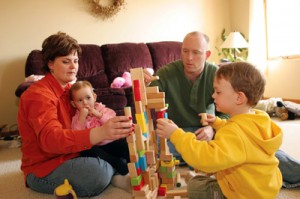
The diocese formed a task force of professionals charged with opening new Early Childhood Development Centers in time for the 2012-2013 academic year. The task force consists of professors from St. John’s, teachers and principals from Catholic parochial schools and academies and staff from the superintendent’s office.
“We have a lot of expertise throughout the diocese,” said Anthony Biscione, deputy superintendent of schools. “The task force is drawing from all that expertise and combining it with the expertise from St. John’s.”
The task force will implement its plans starting with two schools this year: Immaculate Conception School, Jamaica Estates, and Queen of the Rosary Catholic Academy, Williamsburg.
Dorothea Breen, principal of Immaculate Conception, said she is excited to welcome the program into her school because it is an important investment. “The stronger the student is at a younger age, the stronger they will be in the future,” she said.
Maureen Rooney, incoming principal of Queen of the Rosary, said the new centers present an opportunity for the school to build on a service they already provide. She said she has confidence in the plan established by the task force because it does not disregard everything that was already established. Instead, she said, it will enrich the early childhood program in the school.
Dr. Joanne Robertson-Eletto and Dr. Smita Guha, both from St. John’s University, have worked with principals and teachers throughout the summer and will continue to provide faculty development throughout the year.
“We have a vision that celebrates childhood,” said Dr. Robertson-Eletto.
She said it is important to implement educational practices that are age appropriate and nurture the natural curiosity children, ages three to five, demonstrate. She said the task force has agreed to move away from a high dependency on teaching methods more appropriate for older children, such as worksheets, and use methods that are more accessible to young children.
The two schools that will be implementing the plans of the task force this fall were undergoing renovation as The Tablet went to print. Dr. Guha said the new classrooms will be more conducive to creative learning. They will be set up in such a way that students can be taught in either the traditional large group setting or in a project-based setting, she said.
The project-based setting will afford children the opportunity to learn in a more interactive way, Dr. Guha said. For example, there may be stations with blocks, arts and crafts and music.
The key for the teachers, Dr. Guha said, is to cater to children’s own interests. For example, if a teacher discovers that a group of the children are interested in restaurants or cooking, he or she can develop a lesson plan around various aspects of a restaurant. Students can learn math and writing skills by creating a menu; vocabulary skills by learning the names of ingredients, dishes and cooking tools; arts and crafts skills by designing signs and menus; knowledge of cultures by learning about different dishes; and social skills by working in groups.
“It will be more fun for the children,” she said. “They will not even realize they are learning.”
However, the teachers will keep track of the students’ progress, the professor said. Detailed documentation will be required of each teacher so that progress can be monitored throughout the year.
Rooney said she is excited about this approach to learning because it will implement the most recent research on childhood development and will potentially attract more parents to invest in a Catholic school education. She said the changes can already be seen as a playground is built at the Our Lady of Mt. Carmel school building of the Queen of the Rosary Academy.
Dr. Robertson-Eletto said she has focused her research on childhood learning for the past 15 years and is enthused to bring her research into life in Catholic schools. The task force, she said, is taking what it considers the best parts of various teaching methods and implementing them in the two schools this year.
“We are very excited about the potential to bring this model to Catholic schools in Brooklyn and Queens,” said Rooney.
Biscione said he hopes this is only the beginning of the initiative. Once the program proves successful, he said he hopes to propose it to more schools throughout the diocese.
“What we are creating is a model where teachers can come for professional development from other schools so that other schools can learn from and incorporate the same strategies,” he said.
The professors from St. John’s also said they see a potential for the program to be beneficial to their university. Dr. Guha said her graduate students will help create teaching models that will be implemented in the schools, which will give her students real applications to their studies.

One thought on “New Early Development Centers Cater to Young Minds”
You must sign in to leave a comment.